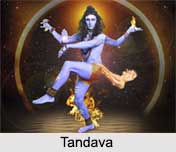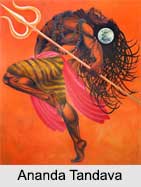 Tandava is a vigorous form of dance which is performed by Lord Shiva. This form of dance represents the cycle of creation, preservation and destruction. It is a dance of passion, anger and powerful energy. Some Hindu texts demote to Lord Shiva’s dances jointly as ‘tandava’ and call this dance the rudra (terrible) tandava, performed when Lord Shiva is angry. It is performed by Lord Shiva and is composed of 108 ‘karanas’ and 32 ‘anghaharas’ according to Bharat Muni’s ‘Natya Shastra’.
Tandava is a vigorous form of dance which is performed by Lord Shiva. This form of dance represents the cycle of creation, preservation and destruction. It is a dance of passion, anger and powerful energy. Some Hindu texts demote to Lord Shiva’s dances jointly as ‘tandava’ and call this dance the rudra (terrible) tandava, performed when Lord Shiva is angry. It is performed by Lord Shiva and is composed of 108 ‘karanas’ and 32 ‘anghaharas’ according to Bharat Muni’s ‘Natya Shastra’.Etymology of Tandava
Tandava dance has derived its name from the word ‘tandu’ who was the attendant of Lord Shiva.
Origin of Tandava
The religious scholars are of the opinion that Tandava is the celestial dance by Lord Shiva. The Hindu scriptures have said that Lord Shiva has performed the tandava dance on various occasions. For instance, it is believed that Lord Shiva had performed the Rudra Tandava when Sati had jumped into fire at the yajna ceremony of Daksha. This form of dance was performed by the Lord to express his grief and anger. Some scholars believe that the feminine form of the tandava dance is the lasya which is performed by Goddess Parvati. Lasya involves graceful movements of the body parts. The body movements in this form of dance are sometimes erotic and sometimes are gentle in nature.
Types of Tandava
According to some scholars, there are around seven types of tandava which are performed by the Lord which he performs in different moods. Following are the different types of Tandava:
Tripura Tandava: It was performed by Lord Shiva after he killed three demons who were as a group known as ‘Tripurasura’. They were the demon Tarakusara’s sons and were named ‘Vidyunmali’, ‘Tarakaksha’ and ‘Viryavana’. This dance represents Lord Shiva’s antagonism and audacity.
Gauri Tandava: It represents the vicious form of Lord Shiva, in which he dances aggressively in the form of ‘Bhairava’ or ‘Veerabhadra’ along with Gauri at a rites ground in the existence of spirit assistants.
 Ananda Tandava: It is his happy form which means the dance of heaven, and symbolises absolute happiness and delight. It is performed by him when he killed ‘Tripurasura’ and finished performing the ‘Tripura Tandava’, when Goddess Uma performed the ‘lasya’ dance to compose him. Her dance satisfied him so significantly that his joy was uttered in the appearance of the ‘ananda tandava’. All the mudras of Ananda Tandava are associated with the rhythmic beat of creation, ensuring the play of the wind with the waves and the tides, the cosmic swirl of the galaxies and the frolic of ethereal beings. In Ananda Tandava, his hands are directed in four different ways denoting four principal directions. The "damru" that refers to the male female vital principle, is on the upper right hand. The lower right hand shows the gesture of assertion. The snakes which are uncoiling from all parts of his body, denotes egotism. The skull is on his head defining his conquest over death and Goddess Ganges is placed on his hairdo. The third eye represents his omnipresence, omnipotence and insight. The sound of "damaru" originates the pristine sound of ‘Om’ (the first syllable of the ancient Sanskrit language).
Ananda Tandava: It is his happy form which means the dance of heaven, and symbolises absolute happiness and delight. It is performed by him when he killed ‘Tripurasura’ and finished performing the ‘Tripura Tandava’, when Goddess Uma performed the ‘lasya’ dance to compose him. Her dance satisfied him so significantly that his joy was uttered in the appearance of the ‘ananda tandava’. All the mudras of Ananda Tandava are associated with the rhythmic beat of creation, ensuring the play of the wind with the waves and the tides, the cosmic swirl of the galaxies and the frolic of ethereal beings. In Ananda Tandava, his hands are directed in four different ways denoting four principal directions. The "damru" that refers to the male female vital principle, is on the upper right hand. The lower right hand shows the gesture of assertion. The snakes which are uncoiling from all parts of his body, denotes egotism. The skull is on his head defining his conquest over death and Goddess Ganges is placed on his hairdo. The third eye represents his omnipresence, omnipotence and insight. The sound of "damaru" originates the pristine sound of ‘Om’ (the first syllable of the ancient Sanskrit language).For more, visit the link below: